Step 1: System requirements and network setup
Before installing PaperCut NG/MF for either evaluation or production use, verify the system requirements:
- The operating system version is supported and patches are up to date (see PaperCut MF System Requirements ).
- PaperCut NG/MF needs to be installed on the system directly hosting the printer(s), that is, the print server.
- Printers are configured correctly and work before installing PaperCut NG/MF.
- In workgroup environments (that is, where no domain is present), some additional configuration is required. For more details see Running in a Workgroup environment .
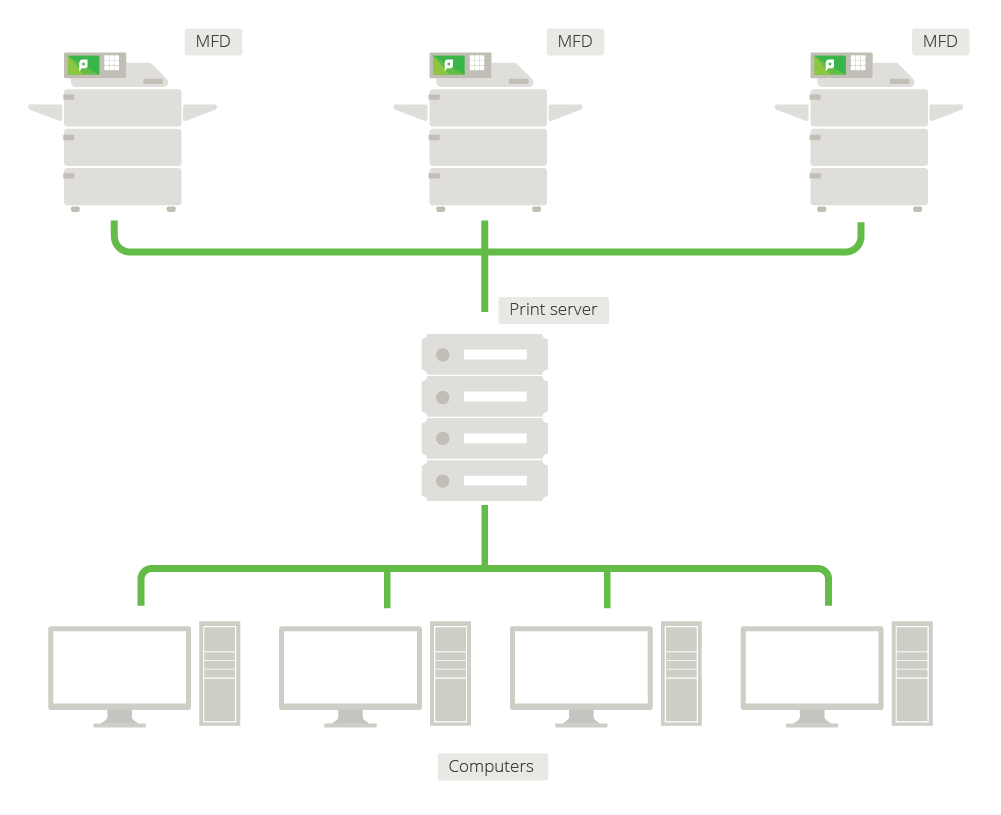
Network printer configuration
Step 2: Print queue configuration
When using Release Stations or account selection popups, PaperCut NG/MF pauses jobs on the Windows print queue to hold jobs prior to printing. It is important, especially in charging environments, that the queue is secured to prevent users from resuming jobs themselves and bypassing PaperCut NG/MF. There are two ways a Windows print queue can be secured:
- Configure the queue using the standard TCP/IP port.
- Restrict the print queue security permissions to prevent users from performing management functions.
Using the PaperCut TCP/IP port
The PaperCut TCP/IP port is required if you are using hardware page count validation. For more information about configuring the PaperCut TCP/IP port, see Windows printer queue configuration . To check which port is being used, have a look at the Printer Properties > Ports tab.
Restricting Windows print queue security permissions
This method works for most versions of Windows. However, it might interfere with printing on Windows 8.1 and Windows 2012R2. On these systems you should secure printing using PaperCut TCP/IP ports.
To restrict security permissions for a queue:
-
Log on as an Administrator to the server hosting the printers.
-
Open the printer configuration screen: Start > Printers.
-
Right-click a printer; then select Printer properties.
-
Select the Security tab.
-
Select the CREATOR OWNER user.
-
In the Permissions area, clear the Manage Documents check box.
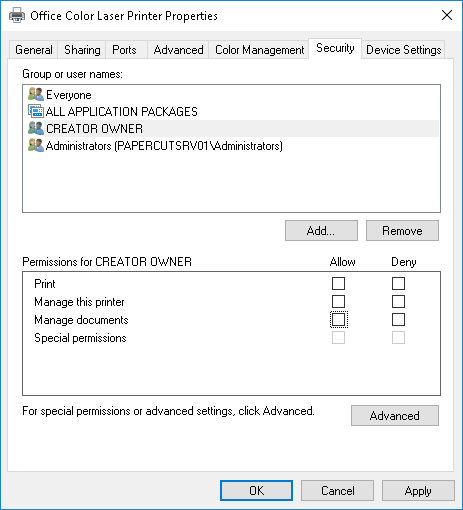
-
Click OK.
-
Perform these steps for each of the monitored printers.
Windows Server 2008 R2 only
Windows Server 2008 R2 installations can experience an issue where print jobs are not removed from the print queue when completed. These jobs stay in the queue with a status of ‘Sent to Printer’. To work around this, configure the Printer Driver Isolation so that jobs are removed from the queue when completed
- Log on as an Administrator to the server hosting the printers.
- Using the Server Manager, navigate to the Print Management Console: Server Manager > Roles > Print and Document Services > Print Management > Print Servers > PrintServerName > Drivers.
- Right-click a printer driver; then select Set Driver Isolation > None.
- Perform these steps for each of the monitored printers drivers.
Windows 2008 R2 installations might require hotfix KB2906850 to be installed. Consult with your Microsoft experts regarding the suitability of this hotfix.
Step 3: Download and install PaperCut NG/MF
PaperCut NG/MF is supplied as a standard Windows pcng-setup-<version>.exe or pcmf-setup-<version>.exe install program.
To download the .exe files:
- PaperCut NG - go to https://www.papercut.com/products/ng
- PaperCut MF - available only from our PaperCut Partners. To find out how to buy or trial PaperCut MF, go to https://www.papercut.com/products/mf/how-to-get/
After the download is complete, run the setup wizard as an administrator. A system restart is not usually required, but you should install on live production systems during periods of low activity, for example, not during backup operations or other administration activities.
-
Double-click the
pcng-setup-<version>.exeinstall program.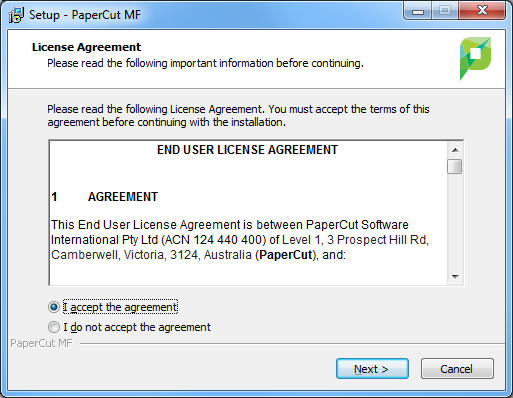
-
Read the End User License Agreement (EULA) .
-
Select I accept the agreement; then click Next.
-
Read the installation information; then click Next.
-
Select the installation location; then click Next.
-
Select Standard installation (primary server); then click Next.
-
Select whether or not you want to create a desktop shortcut; then click Next.
-
Click Install.
-
Click Finish.
Step 4: Run the Configuration Wizard
After you install PaperCut NG/MF, a web browser is displayed with the PaperCut NG/MF Configuration Wizard Welcome screen.
Administrative password
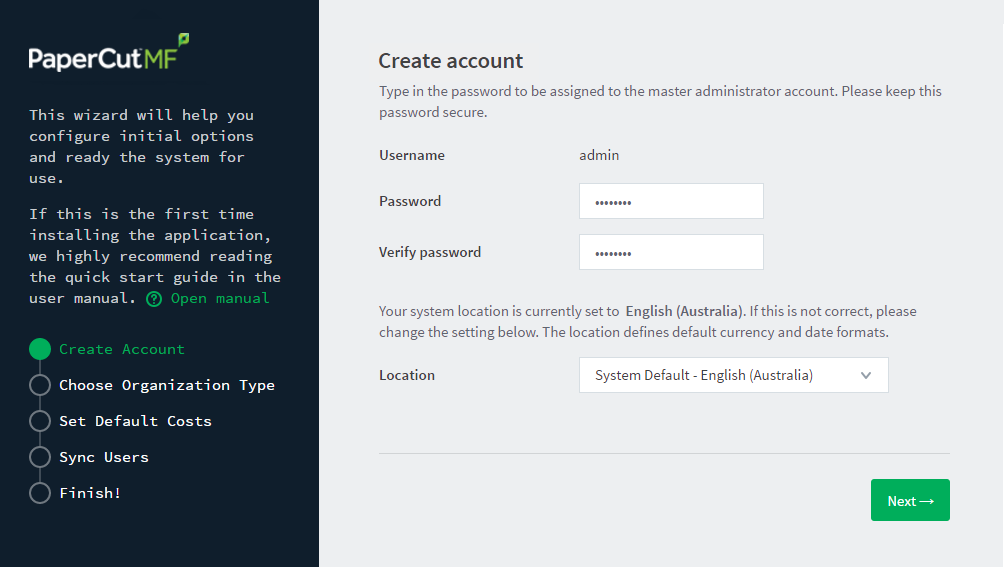
- Complete the following fields:
- Password—enter the password for the main in-built admin account. This password is independent of the operating system or domain passwords. The password must be at least six characters.
- Verify password—re-enter the password.
- Location—select the system’s physical location and language.
- Click Next.
Organization type
The Organization type screen is displayed.
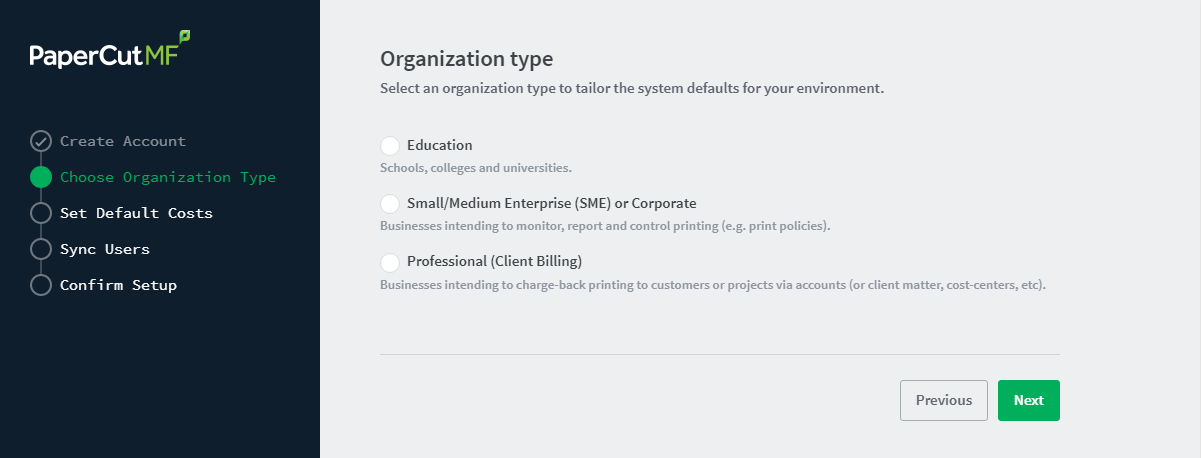
This selection determines which system defaults are used. For example, in a Professional (Client Billing) organization, where it is useful to charge-back printing to customers, an advanced client popup is provided with additional features useful for dealing with large numbers of client (shared) accounts. You can change these default settings chosen for an organization type after installation.
- Select your organization type.
- Click Next.
Default cost for printing
The Default costs for printing screen is displayed.
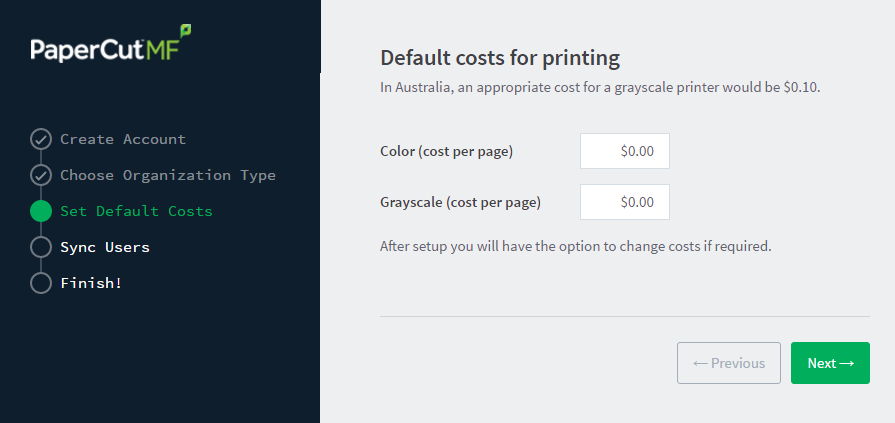
If required, you can change this setting after installation.
- Complete the following fields:
- Color (cost per page)—enter the default cost per page for color printing on all printers.
- Grayscale (cost per page)—enter the default cost per page for grayscale printing on all printers.
- Click Next.
Initial user credit (Education organization type only)
If you selected Education as the organization type, the Initial user credit screen is displayed.
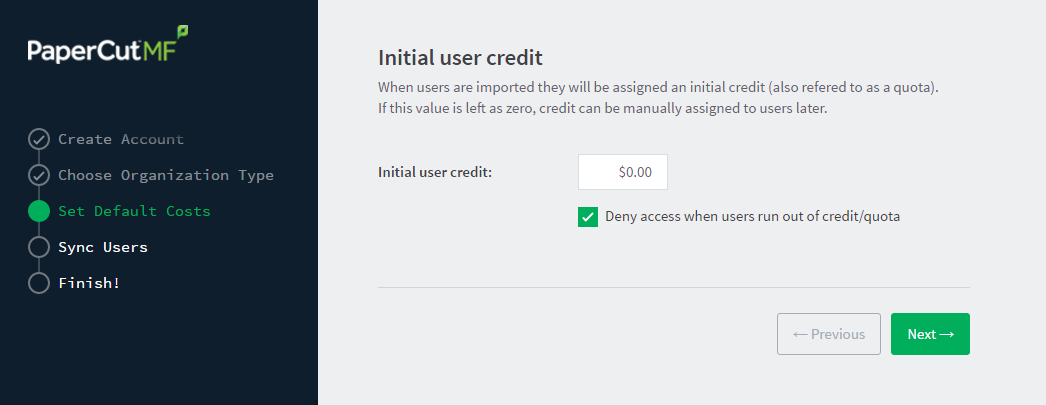
If you selected Small/Medium Enterprise (SME) or Corporate) or Professional (Client Billing) as the organization type, go to step 5.
- Complete the following fields:
- Initial user credit—enter the amount of credit each/quota each user will receive when the system is first enabled. You can change these settings after setup.
- Deny access when users run out of credit/quota—select this check box to prevent users from printing when they run out of credit/quota.
- Click Next.
User/group synchronization
The User/group synchronization screen is displayed.
PaperCut NG/MF extracts user information out of your user directory. PaperCut NG/MF automatically tries to detect the available directory services, saving you hours of configuration time.

- In User source, select the source of user data:
- Windows Standard
- Windows Active Directory
- LDAP
- Azure AD Secure LDAP
- Google Cloud Directory
- Select one of the following options:
- Import all users—import all domain user accounts. This includes all system accounts as well as user accounts. Importing all users is suitable for organizations that do not have user groups (user groups are not imported into PaperCut NG/MF with this options), and does not have a large number of system account.
- Import users from selected groups—import users from selected user groups. This is useful when:
- only a subset of users will use the printers
- you want to report on individual user groups or apply different policies or pricing to different groups
- you have many system accounts
- Click Next.
- For LDAP and Azure AD Secure LDAP, the Server Details page is displayed.
- For Google Cloud Directory, the Google Cloud Directory Details page is displayed.
- Complete the following as required:
LDAP
Complete the following fields:
LDAP Server Type —Determines which LDAP fields are used to get user and group information. PaperCut NG/MF supports the following server types:
Unix / Open Directory
Microsoft Active Directory
Novell eDirectory
However, it is easy to support other server types by adjusting the LDAP fields PaperCut NG/MF searches. For more information, see Advanced LDAP configuration.
LDAP Server Address —The hostname or IP address of the LDAP server.
Use SSL —Indicates if an encrypted SSL connection is used to connect to the LDAP server. The LDAP server requires SSL support to be enabled and should accept connections on the standard LDAPS port 636.
Base DN —The Base DN of the LDAP server. This is the equivalent of the "suffix" config setting of the OpenLDAP server. For example, if the domain hosted by the LDAP server is "domain.com", then the Base DN might be
DC=domain,DC=com. The format of the Base DN can differ significantly depending on configuration. Some older Novell eDirectory installations require a blank Base DN to operate. Some examples:DC=myschool,DC=edu,DC=au,DC=myorganization,DC=com OU=OrgUnit,DC=domain,DC=com,DC=localAdmin DN —The DN of the user who has permission to connect to and query the LDAP server. This is typically an administrative user, although it can be a user that only has read-only access to the LDAP server. An example of the DN of the Administrator user on a Windows AD domain "domain.com", would be
CN=Administrator,CN=Users,DC=domain,DC=com. The exact format of the DN depends on the LDAP server. Some examples:Windows Active Directory:
CN=Administrator,CN=Users,DC=domain,DC=comWindows Active Directory (in organizational unit):
CN=administrator,OU=OrgUnit,DC=domain,DC=comMac Open Directory:
uid=diradmin,CN=users,DC=domain,DC=comUnix Open LDAP:
uid=root,DC=domain,DC=com, oruid=ldapadmin,DC=domain,DC=comNovell eDirectory:
CN=root,DC=domain,DC=com, orCN=ldapadmin,OU=users,DC=domain,DC=com.
The Admin DN and password is optional if your LDAP server allows anonymous binds for querying.
Admin password —The password for the above user.
- Click Test LDAP settings to test and confirm your settings before continuing.
- Click Next .
Azure AD Secure LDAP
- Complete the following fields:
- Accept self-signed certificate—Select this check box if you are using a self-signed certificate that does not need to be validated. If you are using a certificate signed by a trusted authority, clear this checkbox.
- Azure LDAP External Address—Your LDAP external address copied above from Azure AD Secure LDAP.
- Base DN—Your Azure DNS Domain Name. This is the equivalent of the "suffix" config setting of the OpenLDAP server. For example, if the domain hosted by the LDAP server is "domain.com", then the Base DN might be
DC=domain,DC=com. The format of the Base DN can differ significantly depending on configuration. Some older Novell eDirectory installations require a blank Base DN to operate. Some examples:DC=myschool,DC=edu,DC=au,DC=myorganization,DC=com OU=OrgUnit,DC=domain,DC=com,DC=local - AAD DC Administrator username—The Azure Active Directory DC administrator username. For example, admin@papercut.com.
- Admin password—The password for the above user.
- Click Test Settings to test and confirm your settings before continuing.
- Click Next.
Google Cloud Directory
Log in to accounts.google.com using your Super Admin user login details. The Google Admin console is displayed.
Click the Apps tile. The Apps screen is displayed.
Click the LDAP tile. The LDAP screen is displayed.
Click ADD CLIENT.
Type a name for the LDAP client connection you’ll be configuring to use for PaperCut NG/MF (for example, "PaperCut MF"), and optionally type a description; then click CONTINUE. The Access permissions screen is displayed.
In the Verify user credentials section, select either:
Entire domain
<domain name>Selected organizational units; then click Add and select the units from the list. (Use this to limit syncing to users in a subset of groups.)
In the Read user information section, select either
Entire domain
<domain name>Selected organizational units; then either click Copy from Verify user credentials or click Add and select the units from the list. (Use this to limit syncing to users in a subset of groups.)
Depending on your organizational policies, tick all boxes for System attributes, Public custom attributes, and Private custom attributes as this will allow PaperCut to sync primary number and secondary number from custom fields of your choice stored under individual users as per your organization's schema on Google Cloud Directory. More details on this in Quick install: Windows.
In the Read group information section, click the switch to set it to On; then click ADD LDAP CLIENT. Google displays a confirmation message and information about downloading the certificate.
On the same screen, click Download certificate; then save the downloaded certificate (which is a PDF file) in a secure location.
Click CONTINUE TO CLIENT DETAILS. The Settings for
<ldap client name>screen is displayed.Click anywhere in the Service Status box. The Service Status screen is displayed.
Select On for everyone. The service status is updated for everyone.
Click SAVE.
User Client options (Professional Client Billing organization type only)
If you selected Professional (Client Billing), as the organization type, the User client options screen is displayed.
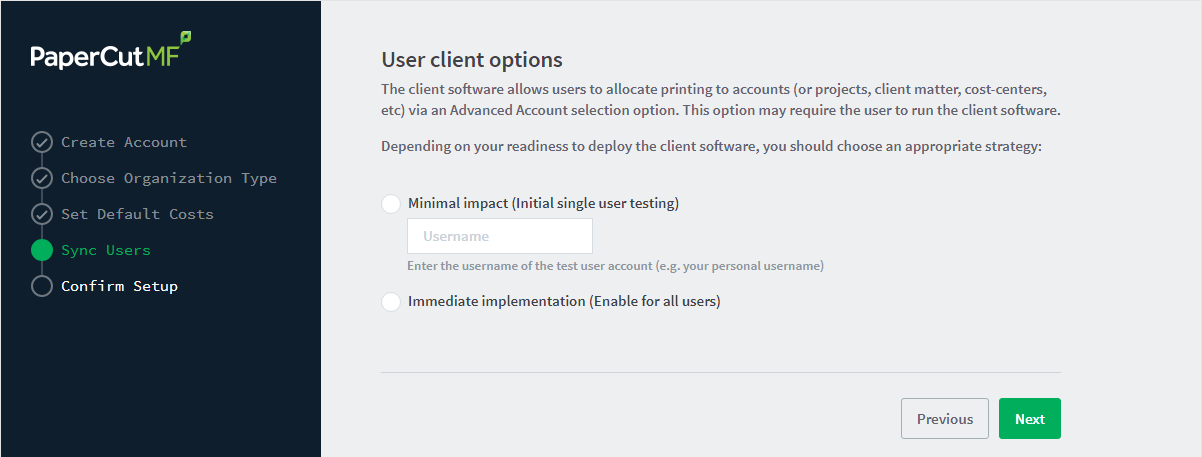
If you selected Education or Small/Medium Enterprise (SME) or Corporate, go to Confirm Setup steps.
Every print job must be charged to an account via the process of Account Selection. This may or not require user interaction and is configured at the user level.
In environments where user interaction for Account Selection is required and the user has both options - User Client and printing device - running the User Client may be optional. Hence, deploying it immediately is also optional. If you choose not to deploy it now, you can still deploy it in the future. However, in environments where user interaction for Account Selection is required and can only be done via the User Client (and cannot be done at the printing device), running the User Client is mandatory. Hence, deploying it immediately is also mandatory. If not, the user is unable to carry out the configured user interaction for Account Selection, and the job remains paused in the print queue and does not appear on the printing device. The User Client can be deployed directly from a network share (which is automatically configured on Windows). There is also the option to install the software locally on each workstation, however, this is not usually recommended because it makes the process of updating the User Client more complicated. For more information about the Account Selection options with and without user interaction (via the User Client or printing device), see Shared accounts , User Client , and Allocating accounts to print jobs at the device .
- Depending on the Account Selection configuration for users (whether or not user interaction is required and whether or not your environment caters for this on the User Client AND on the printing device), select an appropriate User Client deployment strategy:
- Immediate implementation (Enable for all users)—the Account Selection option requiring user interaction is enabled only for all users. If you have configured your users with Account Selection that requires user interaction, and this can only be done on the User Client (and cannot be done on the printing device), then you must install the User Client on all user desktops immediately to prevent disruption of user printing services. If in doubt, select the minimal impact strategy. This ensures the impact is isolated to only the nominated test account.
- Minimal impact (Initial single user testing)—the Account Selection option requiring user interaction is enabled only for a single user for testing purposes. You need to nominate the testing account; this can be an existing system/domain account used for testing purposes or your own user account. The username should be in the format used to log in to the domain/system (usually the short form). Depending on the environment, you can test the user interaction for Account Selection either on the User Client or on the printing device. The minimal impact strategy allows you to test Account Selection with user interaction using the nominated test system/domain user account, after which you can configure other users with similar Account Selection options.
- Click Next.
Confirm setup options
The Confirm setup options screen is displayed.
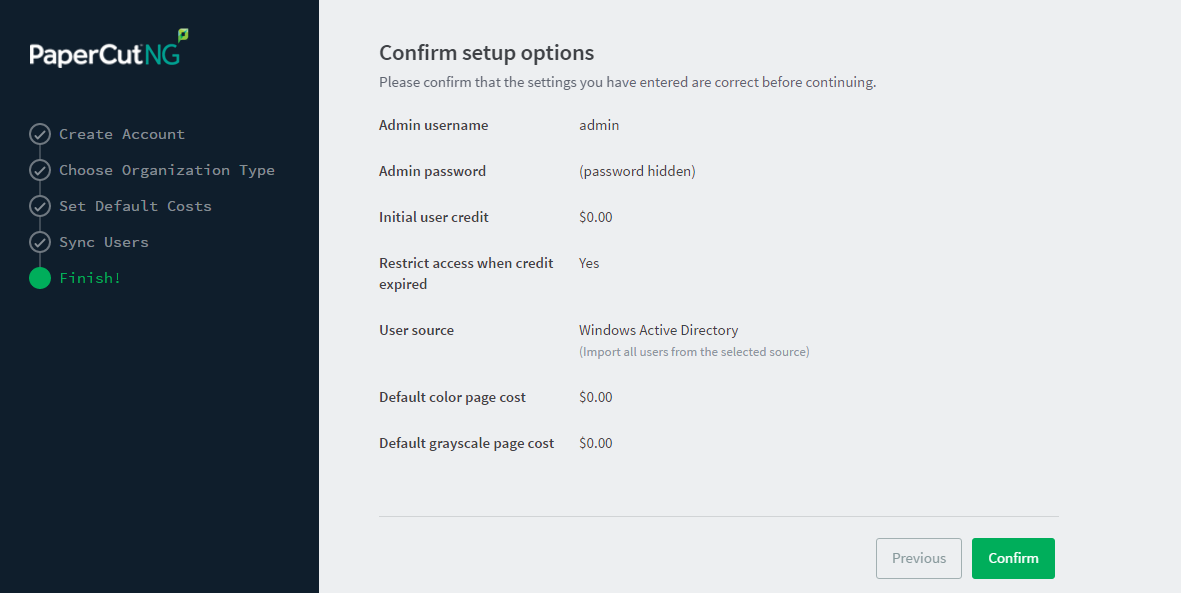
- Check the settings you have entered. If you want to change anything, you can return to any of the configuration screens to alter the options.
- Click Confirm.
The Initial user import screen is displayed.
- Click Close
Setup complete
After completing the configuration wizard you are presented with a user synchronization status screen, showing the progress and results of the setup.
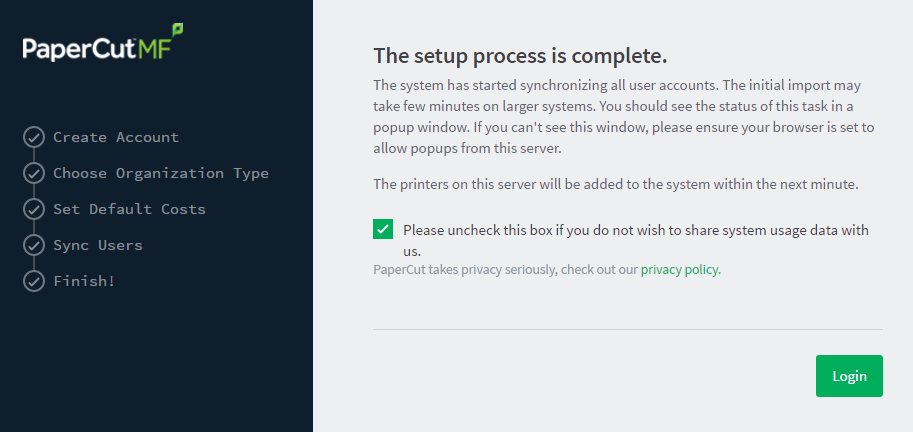
- Click Login to access the Admin web interface and begin familiarizing yourself with the options and features available. Take some time to explore, and refer back to the relevant sections of this manual as required.
Step 5: Check printer configuration
PaperCut NG/MF automatically detects the print queues on the print server on which PaperCut NG/MF is installed. To view the printer list:
- Click the Printers tab.
The Printer List page is displayed. - If the printers are not displayed, print a document. The first job triggers registration of the printer with PaperCut NG/MF.
Step 6: Sharing the User Client Software (optional)
The PaperCut NG/MF client software install package is located in the following directory:
[app-path]/client
- Share this software over the network so workstations can access/install the client application. The directory is automatically shared in read-only form as
PCClientas part of the install process. - Confirm that you can access the client software via the network by browsing to:
\\server\PCClient.
Step 7: User Client deployment (optional)
The PaperCut User Client can now be deployed if required. Some features of the User Client are:
- Display of notification messages, such as why a print job was denied.
- Display of print policies, such as to encourage duplex printing.
- Allowing users to carry out Account Selection with user interaction, such as searching for and locating a specific shared account and assigning it to a job.
- Allowing users to confirm the details and/or cost of their print job before printing.
- Display of users’ current balance (useful in schools where print quotas are used).
- Allowing user authentication when printing from public terminals or other unauthenticated systems.
Every print job must be charged to an account via the process of Account Selection. This may or not require user interaction and is configured at the user level.
In environments where user interaction for Account Selection is required and the user has both options - User Client and printing device - running the User Client may be optional. Hence, deploying it immediately is also optional. If you choose not to deploy it now, you can still deploy it in the future. However, in environments where user interaction for Account Selection is required and can only be done via the User Client (and cannot be done at the printing device), running the User Client is mandatory. Hence, deploying it immediately is also mandatory. If not, the user is unable to carry out the configured user interaction for Account Selection, and the job remains paused in the print queue and does not appear on the printing device. The User Client can be deployed directly from a network share (which is automatically configured on Windows). There is also the option to install the software locally on each workstation, however, this is not usually recommended because it makes the process of updating the User Client more complicated. For more information about the Account Selection options with and without user interaction (via the User Client or printing device), see Shared accounts , User Client , and Allocating accounts to print jobs at the device .
Step 8: Testing
Following a fresh installation, it is highly recommended to test core features of the system. For further details, see Testing the installation .
What next?
Take some time to explore the features of PaperCut NG/MF before continuing reading at Implementation by example or Tour . Business users might be interested in trying the popup client software as covered in Client software . If desired, the client software should also be deployed to other workstations. This procedure is detailed in User Client .






Comments